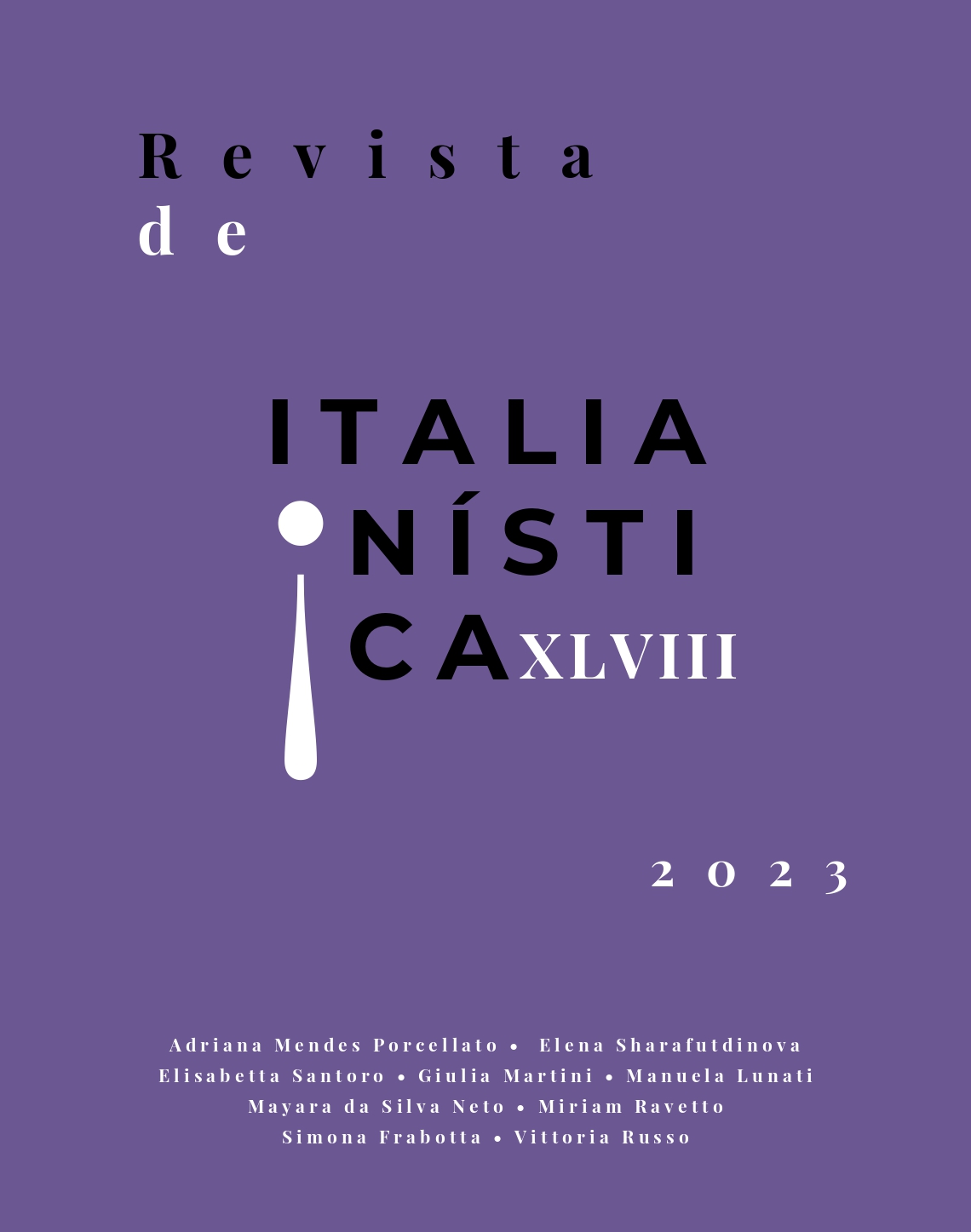A influência da língua materna na aquisição de preposições simples do italiano como segunda língua
DOI:
https://doi.org/10.11606/issn.2238-8281.i48p6-34Palavras-chave:
Transferência linguística, Interferência da L1, Italiano L2, PreposiçõesResumo
A aquisição das preposições constitui um dos aspectos mais difíceis da gramática italiana (KATERINOV, 1975), e foi constatado que a transferência afeta o aprendizado de preposições, que é mediado por vários fatores, inclusive a L1, a duração da intervenção didática, o tipo de tarefa (JARVIS, 2000) e o gênero dos aprendizes (LLACH, 2010). Concentrando-se em uma população de 48 alunos estadunidenses de graduação aprendizes de italiano, entre 18 e 22 anos, igualmente distribuídos quanto ao gênero masculino e feminino e à L1 (n=24 falantes nativos monolíngues de inglês e n=24 falantes bilíngues de espanhol-inglês), esse estudo examinou a influência da respectiva L1 no uso das preposições em italiano L2. Comparou-se também o desempenho dos alunos em diferentes níveis de proficiência para avaliar o efeito do tempo de exposição à L2 na aquisição de preposições em italiano. Além disso, o estudo verificou se os resultados da aprendizagem foram influenciados por diferenças de gênero. Para avaliar o conhecimento dos alunos quanto às preposições da L2 e os tipos de transferência da L1, foram empregadas tarefas de tradução, preenchimento de lacunas, múltipla escolha e julgamento de gramaticalidade. O estudo demonstrou que tanto o tipo de L1 quanto o nível de competência na L2 são fatores que influenciam a aquisição de preposições em italiano L2. Por outro lado, o gênero não parece desempenhar uma função significativa no processo. A análise de erros comprovou que a influência do transfer negativo da L1 diminui com o aumento do nível de proficiência na L2. Por fim, os padrões de transferência e os resultados da aprendizagem não são aparentemente influenciados pelos tipos de tarefas.
Downloads
Referências
ANDERSEN, R. Transfer to somewhere. In GASS S. and L. SELINKER (Eds.). Language transfer in language learning. Rowley, MA: Newbury House, 1983, pp. 177–204.
BU, J. A study of relationships between L1 pragmatic transfer and L2 proficiency. English Language Teaching, v. 5, n. 1, 2012, pp. 32-43. DOI: : http://dx.doi.org/10.5539/elt.v5n1p32
CHEN, F. The L2 acquisition of information sequencing in Chinese: The case of English CSL learners in Taiwan. Electronic Journal of Foreign Language Teaching, v. 4, n. 2, 2007, pp.170-191. Disponibile all'indirizzo: https://e-flt.nus.edu.sg/v4n22007/chen.pdf
CHENG, Y. First language transfer amongst Malay students in national primary schools. Tesi (Master) - University of Malaya, 2001. Disponibile all’indirizzo: http://studentsrepo.um.edu.my/id/eprint/2416
CHOMSKY, N. Aspects of the Theory of Syntax. Boston: The MIT Press, 1965.
CITRARO, C. Il caos preposizionale: analisi dell’errore e didattica. Italica Wratislaviensia, v. 9, n. 2, 2018, pp. 81-92. DOI: https://doi.org/10.15804/IW.2018.09.17
CUMMINS, J. Current research on language transfer. Implications for language teaching policy and practice. In SIEMUND, P.; GOGOLIN, I.; SCHULZ M. EDITH; DAVYDOVA, J. (Eds.). Multilingualism and language diversity in urban areas: Acquisition, identities, space, education. John Benjamins Publishing Company, 2013, pp. 289-304.
DECHERT, H. W.; RAUPACH, M. (Eds.). Transfer in language production. Norwood, NJ: Ablex, 1989.
DOLCI, R.; TAMBURRI, A. (Eds.). Intercomprehension and multilingualism: theory and practice for teaching Romance languages. NY: Queens College’s John D. Calandra American Institute, 2015.
DONATO, C. The Future is multilingual: French, Italian, and Portuguese for Spanish speakers. ADFL Bulletin, v. 44, n. 1, 2016, pp. 112-127. DOI: https://doi.org/10.1632/adfl.44.1.112
DULAY, H.; BURT, M. Natural sequences in child second language acquisition. Language Learning, n. 24, 1974, pp. 37-53. DOI: https://doi.org/10.1111/j.1467-1770.1974.tb00234.x
DULAY, H.; BURT, M.; KRASHEN, S. Language two. Oxford: Oxford University Press, 1981.
FRENDA, A. S. Cross-linguistic comparisons: A case study involving Irish and Italian prepositions. ITB Journal, v. 12, n. 1, 2005, pp. 24-29. DOI: https://doi.org/10.21427/D79B3K
GASS, S. M. An investigation of syntactic transfer in adult L2 learners. In SCARCELLA, R.; KRASHEN, S. (Eds.). Research in second language acquisition. Rowley, MA: Newbury House, 1980, pp. 69-82.
GASS, S. M. A review of interlanguage syntax: language transfer and language universals. Language Learning, v. 34, n. 2, 1984, pp. 115–132. DOI: https://doi.org/10.1111/j.1467-1770.1984.tb01007.x
GASS, S. M. Second language acquisition and linguistic theory: the role of language transfer. In RITCHIE W. and BHATIA T. K. (Eds.). Handbook of Second Language Acquisition. San Diego: Academic Press, 1996, pp. 317–45.
GASS, S. M. Fundamentals of second language acquisition. In ROSENTHAL, J.W. (Ed.), Handbook of undergraduate second language education. Mahwah, NJ.: Lawrence Erlbaum, 2000, pp. 29-46.
GASS, S.; SELINKER, L. (Eds.). Language Transfer in Language Learning. Amsterdam: John Benjamins, 1992.
GASS, S.; SELINKER, L. Second language acquisition: An introductory course. 3rd ed. New York and London: Routledge, 2008 [first edition: 1994].
GÖBEL, K.; VIELUF, S. The effects of language transfer as a resource in instruction. In GROMMES P.; ADELHEID H. (Eds.). Plurilingual education: Policies – practices – language development. Amsterdam: John Benjamins, 2014, pp. 181-196.
HADADI, A.; ABBASI, H. ; GOODARZI, A. How L1 influence changes with regard to L2 proficiency increase. Procedia - Social and Behavioral Sciences, v. 98, 2014, pp. 614-617. DOI: https://doi.org/10.1016/j.sbspro.2014.03.458
HUSSEIN, A.; MOHAMMAD, M. Negative L1 impact on L2 writing. International Journal of Humanities and Social Science, v. 1, n. 18, 2011, pp. 184-195. Disponibile all'indirizzo: https://www.ijhssnet.com/journals/Vol_1_No_18_Special_Issue/22.pdf JARVIS, S. Methodological rigor in the study of transfer: identifying L1 influence in the interlanguage lexicon. Language Learning, v. 50, n. 2, 2000, pp. 245-309. DOI: https://doi.org/10.1111/0023-8333.00118
JIMÉNEZ CATALÁN, R.M. Sex differences in L2 vocabulary learning strategies.
International Journal of Applied Linguistics, v. 13, n. 1, 2003, pp. 54-77. DOI: https://doi. org/10.1111/1473-4192.00037 JIMÉNEZ CATALÁN, R. M.; OJEDA ALBA, J. The English vocabulary of girls and boys: evidence from a quantitative study. In LITOSSELITI L.; SAUTON H.; HARRINGTON K.; SUNDERLAND J. (Eds.) Theoretical and methodological approaches to gender and language study. London: Palgrave Macmillan, 2008.
KATERINOV, K. L’analisi contrastiva e l’analisi degli errori di lingua applicate all’insegnamento dell’italiano a stranieri. Perugia: Edizioni Guerra, 1975.
KELLERMAN, E. Now you see it, now you don’t. In GASS S. and L. SELINKER (Eds.). Language transfer in language learning, Rowley, MA: Newbury House, 1983, pp. 112-134.
KELLERMAN, E. Crosslinguistic influence: transfer to nowhere? Annual Review of Applied Linguistics, v. 15, 1995, pp. 125-150. DOI: https://doi.org/10.1017/S0267190500002658
KELLERMAN, E.; SHARWOOD-SMITH, M. (Eds). Cross-Linguistic Influence in Second Language Acquisition. Elmsford, NY: Pergamon, 1986.
KINDER, J.; SAVINI V. Using Italian. A guide to contemporary usage. Cambridge:Cambridge University Press, 2004.
KRASHEN, S. Writing: research, theory and applications. Oxford: Pergamon Press, 1984.
LADO, R. Linguistics across cultures. Ann Arbor: University of Michigan Press, 1957.
LI, C. Y. Acoustic analysis of Taiwanese learners. Pronunciation in English vowels. Journal of Language and Learning, v. 2, n. 2, 2004, pp. 186-201.
LLACH, M. P. A. An overview of variables affecting lexical transfer in writing. International Journal of Linguistics, v. 2, n. 1, 2010, pp. 2-17. DOI: https://doi.org/10.1017/S0267190500002658
MARTÍNEZ, C. La preposición a ante el objeto directo en italiano/LE: ¿fosilización por interferencia o error de competencia? Cuadernos de investigación en Filología, vv. 29-30, 2004, pp. 269-284. DOI: https://doi.org/10.18172/cif.2193
MASTER, P. A cross—linguistic interlanguage analysis of the acquisition of the English article system. Tesi di dottorato - Los Angeles: University of California, 1987.
MESTHRIE, R.; DUNNE, T. Syntactic variation in language shift: the relative clause in South African Indian English. Language Variation and Change, v. 2, 1990, pp. 31–56. DOI:https://doi.org/10.1017/S0954394500000259
MOSCA, M. Preposizioni a, in, per, tra. L’italiano L2 di parlanti polacchi. Italica Wratislaviensia, v. 9, n. 2, 2018, pp. 195-218. DOI: https://doi.org/10.15804/IW.2018.09.23
NGHI, T. T. Exploring the impact of biological gender on l1 negative transfer in English preposition learning: an explanatory study. Journal of Knowledge Learning and Science Technology, v. 2, n. 1, 2023, pp. 1-12. DOI:https://doi.org/10.60087/9k1aer29
ODLIN, T. Language transfer: Crosslinguistic influence in language learning. Cambridge: Cambridge University Press, 1989.
ODLIN, T. Crosslinguistic influence. In DOUGHTY C. and LONG M. (Eds.). Handbook of second language acquisition. Oxford: Blackwell, 2003, pp. 436-486.
PHOOCHAROENSIL, S. Cross-linguistic influence: its impact on L2 English collocation production. English Language Teaching, v. 6, n. 1, 2013, pp. 1-10. DOI: https://doi.org/10.5539/elt.v6n1p1
RICHARDS, J. Error analysis: perspectives on second language acquisition. London, Longman, 1974.
RINGBOM, H. The role of the first language in foreign language learning. Bristol, Multilingual Matters, 1987.
ROSTAMI ABUSAEEDI, A. A.; BOROOMAND, F. A quantitative analysis of Iranian EFL learners’ sources of written errors. International journal of research studies in language learning, v. 4, v. 1, 2015, pp. 31-42. DOI: https://doi.org/10.5861/ijrsll.2014.682
SALEHI, M. The Acquisition of Preposition Pied Piping and Preposition Stranding by Iranian Learners of English. South Asian Language Review, v. 19, n. 1E2, 2009, pp. 63-77.
SELINKER, L. Language Transfer. General Linguistics. v. 9, 1969, pp. 67-92. SELINKER, L. Interlanguage. IRAL-International Review of Applied Linguistics in Language Teaching, v. 10, n. 1-4, 1972, pp. 209-232. DOI: https://doi.org/10.1515/iral.1972.10.1-4.209
SELINKER, L. Language transfer. In GASS S. and L. SELINKER (Eds.). Language transfer in language learning. Rowley, MA: Newbury House, 1983, pp. 33-68.
SELINKER, L. Rediscovering Interlanguage. London: Longman, 1992.
SOROKINA, E. I. Teaching the prepositional system of the Italian language. Language and Culture, v. 4, n. 16, 2011, pp. 118-126.
TOPIĆ, M. G. Multilinguals’ metalinguistic awareness of function words in L3. Tesi (Diploma) - University of Zagreb, 2016.
VILADOT, J.; CELAYA, M.L. How do you say ‘preparar’? L1 use in EFL oral production and task-related differences. Paper presented at the 30th AEDEAN Conference, University of Huelva, December 14-16, 2006.
WEINREICH, U. Languages in contact. The Hague: Mouton, 1953.
WHITMAN, R.; JACKSON, K. The unpredictability of contrastive analysis. Language Learning, v. 22, 1972, pp. 29-41. DOI: https://doi.org/10.1111/j.1467-1770.1972.tb00071.x
ZUFFEREY, S.; MAK, W.; DEGAND, L.; SANDERS, T. Advanced learners’ comprehension of discourse connectives: The role of L1 transfer across on-line and off- line tasks. Second Language Research, v. 31, n. 3, 2015, pp. 389-411.
Downloads
Publicado
Edição
Seção
Licença
Copyright (c) 2023 Revista de Italianística

Este trabalho está licenciado sob uma licença Creative Commons Attribution-NonCommercial-NoDerivatives 4.0 International License.
A revista retém os direitos patrimoniais dos artigos e os publica simultâneamente sob uma Licença Creative Commons-Atribuição-Não Comercial-Sem Derivações.










